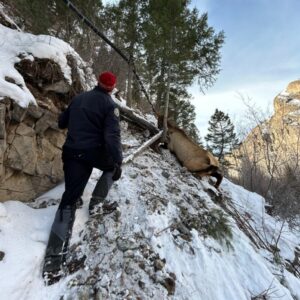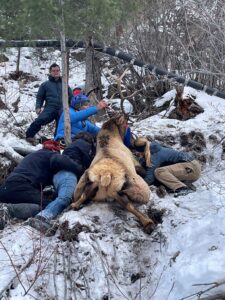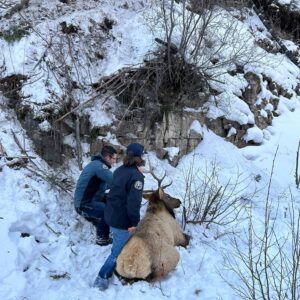By Tom Kuglin, Bugle magazine hunting & outdoor lifestyle editor
Colorado wildlife officials and a group of ice climbers recently teamed up to free a bull elk entangled in a climbing rope and lower it down a cliff face to safety.
On January 3, climbers in Lake City in southwestern Colorado encountered the distressed elk tangled in a fixed climbing rope near one of the area’s popular ice climbing routes. Unable to escape, the 700-pound 2½-year-old exhausted bull lay in the snow on a steep face.
The climbers, who were not from the area, called local law enforcement and Colorado Parks and Wildlife officer Lucas Martin soon responded to the scene. But given the scale and slope of the rescue operation, he quickly realized more reinforcements were needed, says CPW spokesperson John Livingston.
 “Once (Martin) assessed the situation he knew he didn’t have the resources in hand, so he got in touch with our biologist in Gunnison which is about 40 minutes away and they were able to come to assist,” he says.
“Once (Martin) assessed the situation he knew he didn’t have the resources in hand, so he got in touch with our biologist in Gunnison which is about 40 minutes away and they were able to come to assist,” he says.
Biologist Alyssa Meier approached the bull from above and tranquilized it, allowing officials to safely approach and blindfold the animal. The elk appeared to be in good condition but did show some typical wear and tear from the rut including a couple of broken antler tines and some small scaring, says Livingston. The bull also had some minor scrapes from struggling against the rope during the previous night.
Once the rope was cut away, the team still needed to find a way to get the bull down roughly 20 feet to the bottom of the climbing wall. The climbers offered their assistance and helped rig up ropes under the elk’s chest and antlers to safely belay it down.
After administering a drug to reverse the tranquilizer, the elk got to its feet after about 12 minutes and ran down the canyon, bringing an end to the roughly two-hour rescue.
“With how frequently we deal with ungulates, we’re of course a bit concerned about him burning all those calories during this time of year when it’s cold out, but there’s not a lot of snowpack so we’re hopeful that he’ll be able to find some feed and recuperate,” Livingston says.
Livingston praised the climbers for their actions, not only in assisting with the rescue, but for calling in wildlife professionals rather than attempting to free the elk themselves.
 “We’re super thankful to these climbers that did the right thing,” he says. “We always tell people especially when you have an animal stressed like that—they’re unpredictable and thrashing around—that human safety is always at the foremost for us. It’s always best to get the experts out there and let us work to get the animal safe.”
“We’re super thankful to these climbers that did the right thing,” he says. “We always tell people especially when you have an animal stressed like that—they’re unpredictable and thrashing around—that human safety is always at the foremost for us. It’s always best to get the experts out there and let us work to get the animal safe.”
Wildlife officials frequently receive reports of elk, deer and other wildlife entangled in everything from hammocks to Christmas lights to fences—Colorado officials even recently responded to an elk with a tire around its neck—but officials only intervene if the animal is permanently tethered or the object impairs the ability to eat, drink or breathe, Livingston says.
One major obstacle to wildlife is relic fence that can entangle animals. Removing unneeded barbed wire has become a hallmark of Rocky Mountain Elk Foundation volunteer projects, working with landowners and managers to make range and migration routes safer for elk and other wildlife.
Click here to view RMEF’s wildlife-friendly fence modification and construction guide.
(Photo credit: Colorado Parks and Wildlife)
